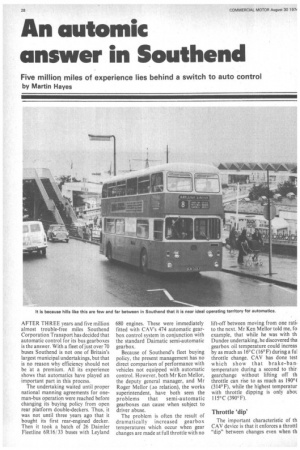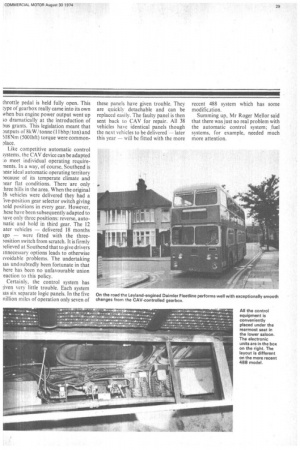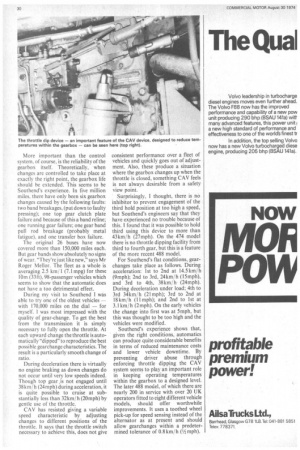An automic answer in Southend
Page 30

Page 31

Page 32

If you've noticed an error in this article please click here to report it so we can fix it.
Five million miles of experience lies behind a switch to auto control
by Martin Hayes
AFTER THREE years and five million almost trouble-free miles Southend Corporation Transport has decided that automatic control for its bus gearboxes is the answer. With a fleet of just over 70 buses Southend is not one of Britain's largest municipal undertakings, but that is no reason why efficiency should not be at a premium. All its experience shows that automatics have played an important part in this process.
The undertaking waited until proper national manning agreements for oneman-bus operation were reached before changing its buying policy from open rear platform double-deckers. Thus, it was not until three years ago that it bought its first rear-engined decker. Then it took a batch of 26 Daimler Fleetline 6R16/33 buses with Leyland 680 engines. These were immediately fitted with CAV's 474 automatic gearbox control system in conjunction with the standard Daimatic semi-automatic gearbox.
Because of Southend's fleet buying policy, the present management has no direct comparison of performance with vehicles not equipped with automatic control. However, both Mr Ken Mellor, the deputy general manager, and Mr Roger Mellor (ao relation), the works superintendent, have both seen the problems that semi-automatic gearboxes can cause when subject to driver abuse.
The problem is often the result of dramatically increased gearbox temperatures which occur when gear changes are made at full throttle with no lift-off between moving from one rati■ to the next. Mr Ken Mellor told me, fo example, that while he was with th Dundee undertaking, he discovered tha gearbox oil temperature could increas by as much as 16°C (16°F) during a fu] throttle change. CAV has done test which show that brake-barn temperature during a second to thin gearchange without lifting off th throttle can rise to as much as 190°( (314°F), while the highest temperatur with throttle dipping is only abut 115°C (390°F).
Throttle `dip'
The important characteristic of th CAV device is that it enforces a throttl "dip" between changes even when th throttle pedal is held fully open. This type of gearbox really came into its own when bus engine power output went up 30 dramatically at the introduction of bus grants. This legislation meant that outputs of 8k W / tonne (11bhp/ ton) and 518Nm (5001bft) torque were commonplace.
Like competitive automatic control ;ystems, the CAV device can be adapted :o meet individual operating requirements. In a way, of course, Southend is :tear ideal automatic operating territory lecause of its temperate climate and 'war flat conditions. There are only :hree hills in the area. When the original Z6 vehicles were delivered they had a 'lye-position gear selector switch giving iold positions in every gear. However, .hese have been subsequently adapted to lave only three positions: reverse, automatic and hold in third gear. The 12 ater vehicles -delivered 18 months igo — were fitted with the three)osition switch from scratch. It is firmly )elieved at Southend that to give drivers innecessary options leads to otherwise voidable problems. The undertaking as undoubtedly been fortunate in that here has been no unfavourable union eaction to this policy.
Certainly, the control system has ;iven very little trouble. Each system las six separate logic panels. In the five nillion miles of operation only seven of these panels have given trouble. They are quickly detachable and can be replaced easily. The faulty panel is then sent back to CAV for repair. All 38 vehicles have identical panels though the next vehicles to be delivered later this year — will he fitted with the more recent 488 system which has some modification.
Summing up, Mr Roger Mellor said that there was just no real problem with the automatic control system; fuel systems, for example, needed much more attention.
More important than the control system, of course, is the reliability of the gearbox itself. Theoretically, when changes are controlled to take place at exactly the right point, the gearbox life should be extended. This seems to be Southend's experience. In five million miles. there have only been six gearbox changes caused by the following faults: two band breakages, (put down to faulty pressing); one top gear clutch plate failure and because of this a band reline; one running gear failure; one gear band pull rod breakage (probably metal fatigue), and one transfer box failure.
The original 26 buses have now covered more than 150,000 miles each. But gear bands show absolutely no signs of wear. "They're just like new," says Mr Roger Mellor. The fleet as a whole is averaging 2.5 km/1 (7.1mpg) for these 1-0 m (33 ft). 98-passenger vehicles which seems to show that the automatic does not have a too detrimental effect.
During my visit to Southend I was able to try one of the oldest vehicles -with 170.000 miles on the dial — for myself. I was most impressed with the quality of gear-change. To get the best from the transmission it is simply necessary to fully open the throttle. At each upward change the throttle is automatically "dipped" to reproduce the best possible gearchange characteristics. The result is a particularly smooth change of ratio.
During deceleration there is virtually no engine braking as down changes do not occur until very low speeds indeed. Though top gear ,is not engaged until 38 km / h (24 mph) during acceleration, it is quite possible to cruise at substantially less than 32km / h (20mph) by gentle use of the throttle.
CAV has resisted giving a variable speed characteristic by adjusting changes to different positions of the throttle. It says that the throttle switch necessary to achieve this, does not give consistent performance over a fleet of vehicles and quickly goes out of adjustment. Also, these produce a situation where the gearbox changes up when the throttle is closed, something CAV feels is not always desirable from a safety view point.
Surprisingly. I thought, there is no inhibitor to prevent engagement of the third hold position at too high a speed, but Southend's engineers say that they have experienced no trouble because of this. I found that it was possible to hold third using this device to more than 43km/ h (27mph). On the 474 model there is no throttle dipping facility from third to fourth gear, but this is a feature of the more recent 488 model.
For Southend's flat conditions, gearchanges take place as follows. During acceleration: 1st to 2nd at 14.5 km/ h (9mph); 2nd to 3rd, 24km/ h (15mph), and 3rd to 4th, 38km/ h (24mph). During deceleration under load; 4th to 3rd 34km th (21mph); 3rd to 2nd at 18 km/h (11mph); and 2nd to 1st at 3.1 km/h (2mph). On the early vehicles the change into first was at 5mph, but this was thought to be too high and the vehicles were modified.
Southend's experience shows that, given the right conditions, automatics can produce quite considerable benefits in terms of reduced maintenance costs and lower vehicle downtime. By preventing driver abuse through enforcing throttle dipping the CAV system seems to play an important role in keeping operating temperatures within the gearbox to a designed level. The later 488 model, of which there are nearly 200 in service with over 20 UK operators fitted to eight different vehicle models, should offer worthwhile improvements. It uses a toothed wheel pick-up for speed sensing instead of the alternator as at present and should allow gearchanges within a predetermined tolerance of 0.8 km/h (1/2 mph).




































































































